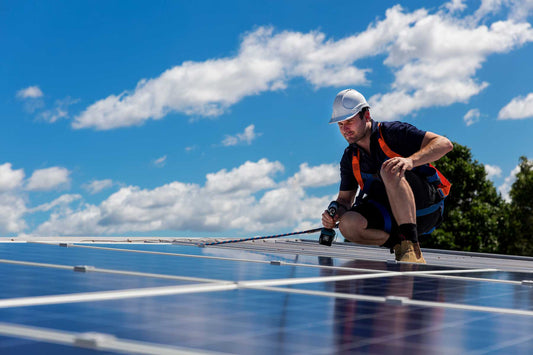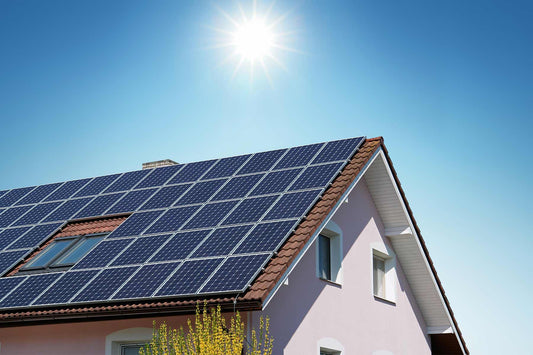At this point, you’ve heard the benefits of going solar: reduced energy costs, energy independence, and even an increase in home value. However, before you commit to this renewable energy source, it’s a good idea to learn about peak sun hours.
Peak sun hours refer to the number of hours per day that a solar panel system receives direct, intense sunlight. This figure varies significantly from state to state, so before you switch to a solar system, you need to determine how feasible solar energy is in your area.
Below, we have included a complete guide on peak sun hours, as well as an interactive table to find the amount your area gets per year. Read on to find out if making the switch to solar makes sense for your home.
What Are Peak Sun Hours?
A peak sun hour refers to the intensity of the sun, and it can be described as an hour of sunlight that equals or exceeds 1,000 watts of energy per square meter (W/m²).
This figure isn’t simply the hours between sunrise and sunset, but a measurement of how much energy the sun provides in a given day. This is important because the more peak sun hours a solar system experiences, the more energy it can generate.

On any given day, some areas of the country can experience over seven peak sun hours, while others may receive as few as four or less. It all depends on the season, sun position, and geographic location.
How Do I Check My Peak Sun Hours?
To check the peak sun hours in your area, simply input your location information below. From there, you will receive a personalized estimate.
Keep in mind that this figure represents peak sun hours when solar panels are tilted at the optimum angle. Therefore, it’s important to have a solar system installed by a trained professional.
Also note that these numbers are based on national and yearly averages, and are meant to give a rough estimate from which you can do independent research.
Peak Sun Hours By State
If you’re curious about how your area stacks up to the rest of the country, we’ve included a comprehensive list that shows the average peak sun hours for all states below.
| State | Average Peak Sun Hours |
|---|---|
| Alabama | 4.23 |
| Alaska | 3.99 |
| Arizona | 6.57 |
| Arkansas | 4.69 |
| California | 5.38 |
| Colorado | 4.87 |
| Connecticut | 3.84 |
| Delaware | 4.23 |
| Florida | 5.67 |
| Georgia | 4.74 |
| Hawaii | 6.02 |
| Idaho | 4.92 |
| Illinois | 3.14 |
| Indiana | 4.21 |
| Iowa | 4.55 |
| Kansas | 5.79 |
| Kentucky | 4.94 |
| Louisiana | 4.92 |
| Maine | 4.51 |
| Maryland | 4.47 |
| Massachusetts | 3.84 |
| Michigan | 4.0 |
| Minnesota | 4.53 |
| Mississippi | 4.44 |
| Missouri | 4.73 |
| Montana | 4.93 |
| Nebraska | 4.79 |
| Nevada | 6.41 |
| New Hampshire | 4.61 |
| New Jersey | 4.21 |
| New Mexico | 6.77 |
| New York | 3.79 |
| North Carolina | 4.71 |
| North Dakota | 5.01 |
| Ohio | 4.15 |
| Oklahoma | 5.59 |
| Oregon | 4.03 |
| Pennsylvania | 3.91 |
| Rhode Island | 4.23 |
| South Carolina | 5.06 |
| South Dakota | 5.23 |
| Tennessee | 4.45 |
| Texas | 4.92 |
| Utah | 5.26 |
| Vermont | 4.13 |
| Virginia | 4.13 |
| Washington | 3.57 |
| West Virginia | 3.65 |
| Wisconsin | 4.29 |
| Wyoming | 6.06 |
How Are Peak Sun Hours Measured?
Peak sun hours are measured in solar irradiance, which is the light-based energy that’s emitted from the sun.
As soon as the sun peeks above the horizon until it completely sets for the night, it gives off a level of irradiance that we can measure in watts. An important consideration, however, is that solar irradiance is not equal at all hours of the day. The angle of the sun, the angle of the solar panels, as well as the age of the solar panels all play an important role in how much energy can be absorbed.
A peak sun hour has an energy equal to or greater than 1,000 W/m² and is usually achieved on sunny days between the hours of 11 a.m. and 4 p.m. However, that doesn’t mean there isn’t any useful energy to be gathered outside of this time — cloudy days or low-light periods may still see energy of 400 W/m² per hour, for example. While less productive than a peak sun hour, this time period still contributes to solar energy absorption.
Are Peak Sun Hours Different From the Average Hours of Sunlight per Day?
The average hours of sunlight per day refers to how much sunshine an area receives on average. This number is based on how often the sun is visible, and has no qualification based on intensity.
Peak sun hours, on the other hand, refer to an hour of sunlight that equals or exceeds 1,000 watts of energy per square meter. This figure is based on the intensity and position of the sun, and is a more accurate number for determining how well a solar panel system will perform.
Although solar panels work on cloudy days, peak sun hours are a much more accurate measurement of potential solar energy than the average hours of sunlight per day in an area.
What Time of Day Do Solar Panels Work Best?
Solar panels work best during peak sun hours. This can be different for every area, but usually falls between 11 a.m. and 4 p.m.
To maximize the amount of intense sunlight that your solar panels receive, make sure there are no system malfunctions and that the panels are not limited by trees or other obstructions that restrict sunlight.
How Big of a Solar System Do I Need?
The size of your solar panel system depends on a few factors in regard to efficiency, space, and peak sun hours. Our comprehensive solar sizing guide gives an in-depth look at all considerations, but a few questions to ask yourself to get started include:
- What is my budget?
- How much space do I have on my roof?
- How much electricity does my household use per month?
- How many peak sun hours does my area receive?
- How efficient are my current or future solar panels?
Once these questions are answered, you can get a better picture of what it will take to get a solar system, the appropriate size, and how efficient it could be for your home.
In the meantime, if you are serious about making the switch to solar energy, Solartap’s low-cost, efficient solar panels can provide you with a reliable energy system for a fraction of the price of other solar systems.
Get a quote using our solar calculator and begin your journey to energy independence today!




